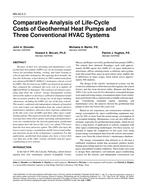
MN-00-05-3 — Comparative Analysis of Life-Cycle Costs of Geothermal Heat Pumps and Three Conventional HVAC Systems
- Comments Off on MN-00-05-3 — Comparative Analysis of Life-Cycle Costs of Geothermal Heat Pumps and Three Conventional HVAC Systems
- ASHRAE
Because of their low operating and maintenance costs, geothermal heat pumps (GHPs) are an increasingly popular choice for providing heating, cooling, and water heating to schools and other institutions. Recognizing these benefits, the Lincoln, Nebraska, school district in 1995 commissioned four new identical 69,000 ft2 (6400 m2 ) elementary schools served by GHPs. The decision to use GHPs was based on an analysis that compared the estimated life-cycle cost of a number of different HVAC technologies. The existence of extensive operating data from the schools’ energy management systems allowed the authors to develop a calibrated simulation model that accurately predicts the energy use of all major building subsystems, including the GHPs, for one of the four schools. This model, combined with independent estimates of installed costs and actual cost information from the school district’s maintenance database, allowed a more rigorous comparison of the life-cycle costs of GHPs and three other space-conditioning options. This paper presents the results of that compar-ison and shows that when capital, operating, and maintenance costs are considered for the Lincoln application, geothermal heat pumps have the lowest life-cycle cost, about 15% lower than the next most attractive option. The GHPs also have the lowest source energy consumption and the lowest total pollutant emissions of any of the technologies considered. For this application, geothermal heat pumps also have a lower first cost than any of the other systems currently used for space conditioning in new schools.
Units: Dual
Citation: Symposium, ASHRAE Transactions, vol. 106, pt. 2
Product Details
- Published:
- 2000
- Number of Pages:
- 10
- File Size:
- 1 file , 370 KB
- Product Code(s):
- D-7255

